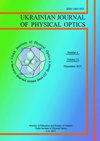介电基板上随机排列的金纳米棒系统的表面定域等离子体共振
IF 8.6
4区 物理与天体物理
0 OPTICS
引用次数: 2
摘要
。采用电化学沉积方法成功制备了准六边形的金纳米棒阵列,并对其光学性质进行了研究。本文分析了两层结构的光学响应,其中第一层是由金纳米棒组成的纳米复合材料,第二层是在玻璃衬底上的氧化铟锡薄膜。利用静电近似法模拟了金纳米棒在不同偏心率下的吸收截面与光波长的关系。结果表明,在玻璃基板上沉积的金纳米棒中,纵向等离子体共振优于其他共振。利用麦克斯韦-加内特理论和矩阵法预测了整个结构的光学特性。我们已经证明,使用适当的模拟结果来估计纳米棒在表面上的浓度是可能的。此外,通过改变纳米棒的几何形状,可以在给定波长下获得有效的吸收特性。特别是,当纳米棒变得足够高且直径变小时,吸收峰向近红外区移动。本文章由计算机程序翻译,如有差异,请以英文原文为准。
Surface-localized plasmon resonance in a system of randomly arranged gold nanorods on a dielectric substrate
. Gold-nanorod arrays of a quasi-hexagonal shape are successfully obtained with electrochemical deposition method and their optical properties are investigated. The optical response of a two-layer structure, in which the first layer is a nanocomposite consisting of Au nanorods and the second one is a thin indium tin oxide film on a glass substrate, has been analyzed. Dependences of absorption cross-section of Au nanorods on the light wavelength at different eccentricities are modelled using electrostatic approximation. It is shown that longitudinal plasmon resonance prevails over other resonances for the Au nanorods deposited on glass substrates. A Maxwell−Garnett theory and a matrix method are used to predict the optical characteristics of the whole structure. We have demonstrated that it is possible to estimate the concentration of nanorods on the surface using the appropriate simulation results. In addition, efficient absorption properties can be obtained at a given wavelength by changing the geometry of nanorods. In particular, there is a shift of the absorption peak towards near-infrared region whenever the nanorods become high enough and smaller in diameter.
求助全文
通过发布文献求助,成功后即可免费获取论文全文。
去求助
来源期刊
CiteScore
9.90
自引率
0.00%
发文量
20
审稿时长
>12 weeks
期刊介绍:
“Ukrainian Journal of Physical Optics” contains original and review articles in the fields of crystal optics, piezo-, electro-, magneto- and acoustooptics, optical properties of solids and liquids in the course of phase transitions, nonlinear optics, holography, singular optics, laser physics, spectroscopy, biooptics, physical principles of operation of optoelectronic devices and systems, which need rapid publication.
The journal was founded in 2000 by the Institute of Physical Optics of the Ministry of Education and Science of Ukraine.

 求助内容:
求助内容: 应助结果提醒方式:
应助结果提醒方式:


